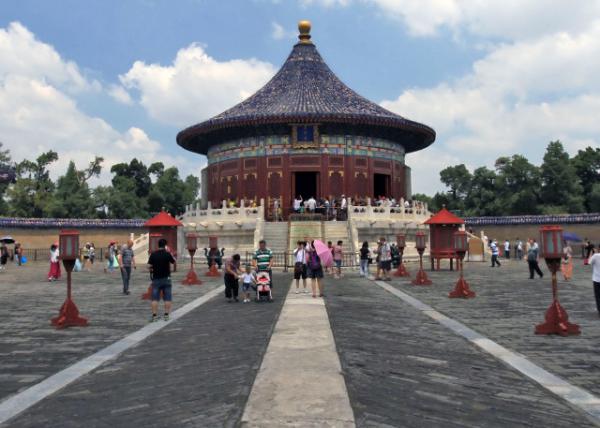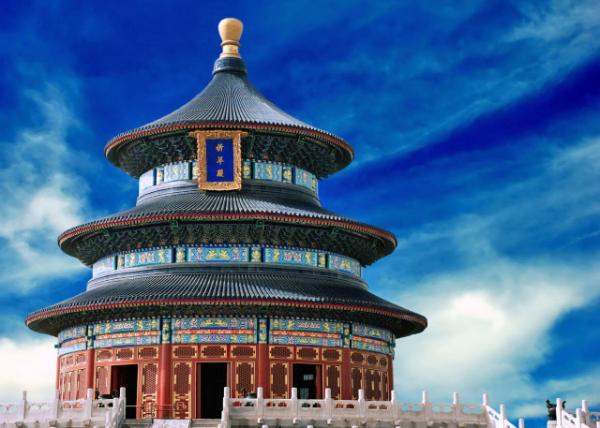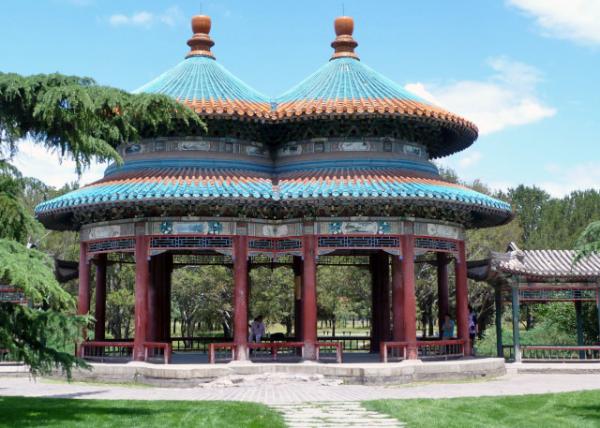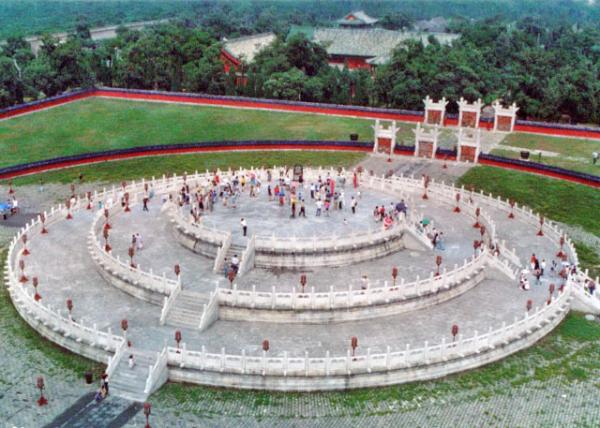| Temple of Heaven, Beijing(北京天壇) |
| 送交者: 天邊的紅霞 2020年05月07日07:18:32 於 [五 味 齋] 發送悄悄話 |
|
2015-08-27
【Aiden in English】 The sky has been important in Chinese history since the beginning of its culture. I mean, which culture doesn’t worship never-ending blue what-cha-ma-call-it above its head. The Chinese emperors had constructed an enormous place known as the Temple of Heaven where they could talk to the sky, worship the sky, and watch the sky. Nowadays, there isn’t much sky to watch other than pollution and smog in Beijing, but that’s not the point. There were three main buildings that made up the Temple of Heaven, yet not all of their purposes for worshipping though. The Hall of Prayer for Good Harvests was the emperor’s personal worshipping area. With a special decoration of the phoenix pattern, this triple-gabled round hall built for the sky caught my eye immediately. Of all the Chinese parks or memorial places I’ve been to, none in which were built circularly. The roof was also blue, something I didn’t see very often. Apparently, there was a level of status given and represented by the color of the roof. Blue was the top tier with the gods, and then yellow for the emperor beneath them. It was actually a pleasant surprise of having a culture where the ruler admittedly said how he was not a god or its equivalent level. There are 28 pillars in the Hall of Prayer for Good Harvests, i.e. four central dragon-well pillars for four seasons, 12 golden pillars in the middle for 12 months of a year, 12 peripheral pillars for the 12 early branches of a day, 24 outer pillars for 24 solar terms, 28 internal pillars for the 28 mansions, 36 backbones of 28 internal pillars and eight upper bronze columns for the 36 Heavenly Spirits. The ancient Chinese were stunning architects, and one of the most monumental accomplishments was building the Echo Wall. The Imperial Vault of Heaven looked circular but it wasn’t a perfect circle. Because of its irregular shape, the sound waves could run around the outer wall and be heard on the opposite side of this circular structure like a voice from heaven. For such an ancient civilization, mastering the art of sound was incredible. Today, the outer wall was blocked off because idiots kept caving their names onto the stone. The architecture was very precise, but now, the small markings threw the sound off, ruining the magic. Probably the most famous of three main buildings would be The Circular Mound Altar. This was the place where the emperor would have a chat with the sky, although I’m sure it’s not a conversation when there was only one person talking. Like the other temple, this platform had three flights of nine steps. No. 9 is the largest number in Chinese culture, which was also the emperor’s personal number. It sounds weird having a number dedicated to you and only you can use. Then the platform itself was built off of the number nine concept. The inner ring of tiles contained nine tiles, the next had 18, the third had 27, etc. It went all the way up to 81. And in the center of this mathematical altar was a single, protruding marble known as the Heart of Heaven. It was the very stone that an emperor stood to talk about. Apparently, it made him closer to the sky. Yeah, just by like two centimeters. The sky is one common worshipping theme in all cultures. It can bring rain and sun for nature, heatwaves and acrid cold for us, or droughts and floods for crops. It’s all up to the sky to choose, and it’s wise to try and persuade it to aid, not destroy. 【紅霞譯文】 盤古開天以來,上蒼在中國歷史上占據着重要地位,說實在的,沒有一個文化不祈禱腦袋瓜上頂的那片無邊無際蔚藍色隨你怎麼稱呼的天空。 於是,中國皇帝便下令修建巨大無比的天壇來祈福民生,在那裡他們能與老天爺聊天,可以祭祀昊天上帝,甚至靜觀天象。如今,北京上空不是污染就是霧霾,難得一見晴朗天空,但這些不是我要談的話題。天壇里有三座主要建築物,並非全部都用來祈谷祭天。 祈年殿是皇帝親臨祈禱的地方,這個專為敬天禮神而設並特別配以金鳳和璽彩畫裝飾的三重屋檐圓形建築立刻吸引了我的注意力。在本人見過的所有中國祭祀場所從未看到任何像眼前這樣圓形結構。祈年殿頂端被塗成罕見的藍色,顯然,只有特殊建築房頂才會使用這種顏色,藍色暗指上蒼,黃色明指皇帝。令人驚喜地發現,在依靠奉天行事的文化國度里,以真龍天子自居的統治者公然承認藍色至高無上,是天神的化身,而自己不是天神,頂多算作天神的臣民。祈年殿共有廿八根柱子,四根中央龍井柱象徵着春夏秋冬四個季節,十二根中層金柱表示一年十二個月,十二根檐柱代表一天十二個時辰,廿四根外柱意指每年廿四節氣,廿八根內柱襯托天上廿八星宿,由廿八根內柱和八根銅柱組合而成的卅六根頂梁柱體現卅六天罡。 古代中華建築師一直享有盛名,最具造詣的傑出作品之一就是回音壁。皇穹宇呈圓形,其弧度畢竟不像圓那樣規範。正因如此,聲波能夠沿着牆壁折射向前,將耳朵貼在牆壁外面可以清楚地聽到身處另外一端人發話,着實體味“天人感應”。對於古代文明,先輩們如此精通高深技術令人驚嘆不已。如今回音壁的傳聲功能已大大消退,原因出自有些無法無天的人在石牆上刻字,從而破壞了牆壁表面的平滑性,使得神奇效果蕩然無存。 在三座主要大殿中名聲最響的是圜丘壇,這是皇帝與老天爺套近乎的地方,當然我敢保證所謂拉呱莫過於一個人自言自語。正如其它祭殿,圜丘壇共分三層,每一層有九級台階,因為九是中國文字中最大的陽數,所以也成了皇帝專用數字,世上竟有一數字為你而設,而且被你化為己有,聽起來該有多彆扭。祭壇嚴格貫徹“九”(久)字精神。內圈有九塊瓷磚,第二圈有十八塊瓷磚,第三圈有廿七塊瓷磚級,最後一圈共有八十一塊瓷磚。在計算精密的同心圓中心鑲嵌着天心石,那可是“上天垂象,億兆景從”一呼百應的大理石,皇帝站在上面頓覺與老天爺拉近了距離,哪怕僅有兩厘米之別。 世上所有民族文化都格外崇拜穹蒼,它讓大自然充滿雨露陽光,給人類帶來酷暑嚴寒,讓農作物耐受旱亢瀝澇,說來真是想幹什麼就幹什麼。因此明智的做法就是,要好好利用它為我們造福,而不要違背天理與它對立。
|
|
|
|
|
 |
 |
| 實用資訊 | |
|
|
|
|
| 一周點擊熱帖 | 更多>> |
|
|
|
| 一周回復熱帖 |
|
|
|
|
| 歷史上的今天:回復熱帖 |
| 2019: | 有人要哭了。 | |
| 2019: | 如果川普周五真的提升關稅到25%。 那香 | |
| 2018: | 呵呵。拋個書包,“硅”字諗啥? | |
| 2018: | 北大校長念白字,好像不是那麼簡單的事 | |
| 2017: | 海黃生活賽天朝 | |
| 2017: | 說個屁啊。空氣流過彈頭表面會升溫還是 | |
| 2016: | Marx Was Right: Five Surprisin | |
| 2016: | 四十歲遇到二十歲那年的初戀 | |
| 2015: | 和老巫談談詩詞的韻律問題 | |
| 2015: | 說法語在這裡太小眾,推薦一篇科普英文 | |










